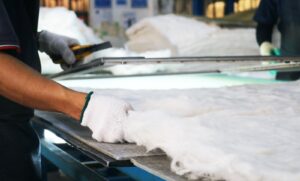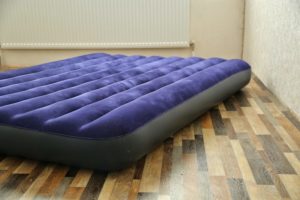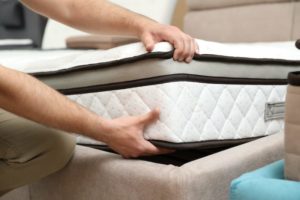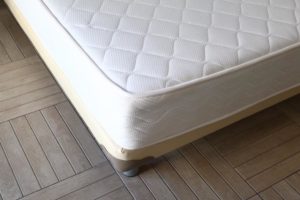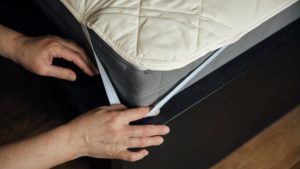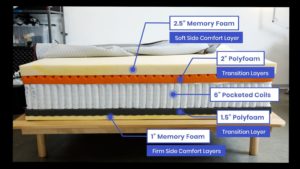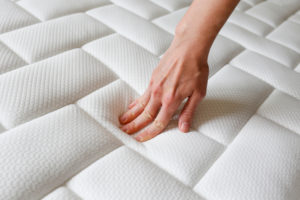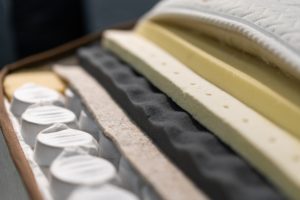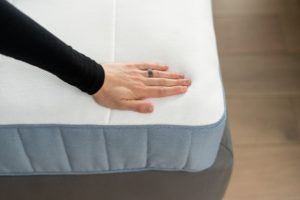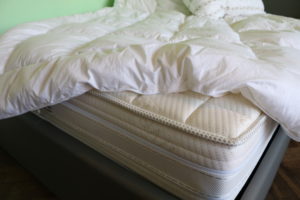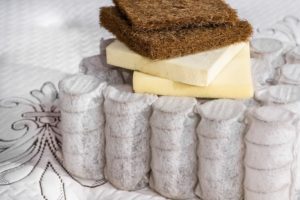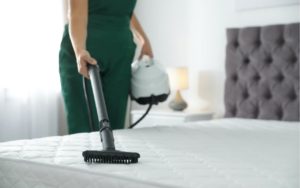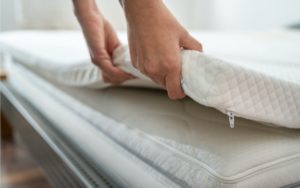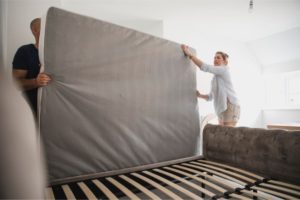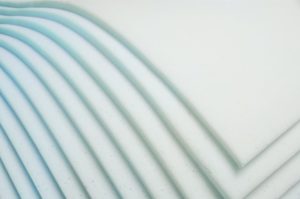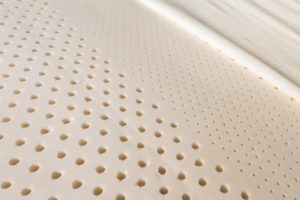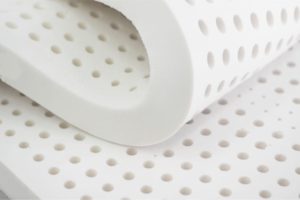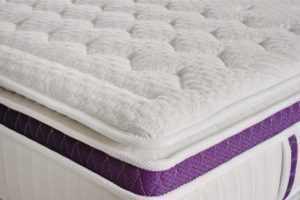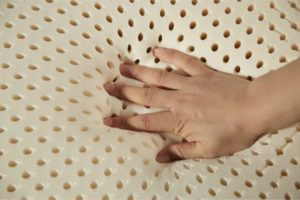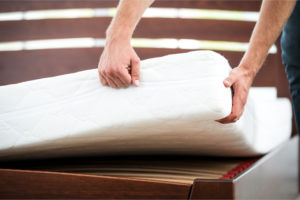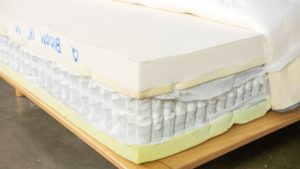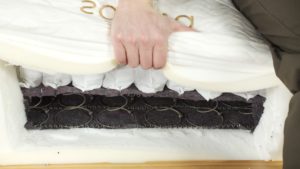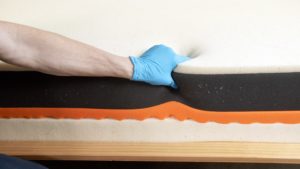Is Memory Foam Toxic?
Memory foam mattresses have increased in popularity over the last few years, and many sleepers with hip, back, or shoulder pain find that memory foam offers unparalleled pressure relief. However, some sleepers still feel hesitant to opt for a memory foam mattress, citing concerns over the health and safety of the chemicals used to make memory foam.
While searching for a comfortable mattress may be top priority, it also makes sense to research the health and safety of the mattress you’re buying. We’ll dig further into what memory foam is, how it’s made, and the potential health effects it may have.
What Is Memory Foam?
Memory foam is a type of polyurethane foam. As with all foams, memory foam compresses under pressure. The difference with other polyurethane foams is that memory foam also contains added chemicals that increase its viscosity and elasticity, hence its alternate name, viscoelastic foam.
When pressure is applied, memory foam has the ability to be stretched into different shapes, and then slowly return to its original form when the pressure is lifted. Thanks to these attributes, memory foam excels at absorbing energy to provide pressure relief.
Memory foam was originally developed by NASA in the 1960’s to provide cushioning against vibrations and potential crashes. Later, the material was used to prevent bedsores for patients who were unable to move for long periods of time. In the 1990’s, TempurPedic brought the world the first memory foam mattress.
Because memory foam is activated by heat, it easily molds to the shape of your body and provides relief and support for your specific body shape. Memory foam also excels at preventing motion transfer from one partner to another. Newer generations of memory foam incorporate elements that strive to reduce heat retention and enable easier movement on top of the bed.
What Is Memory Foam Made Of?
Specific memory foam ingredients vary from company to company. However, virtually all flexible polyurethane foams contain a few basic ingredients:
- Polyols are the basic building blocks of memory foam. These are molecules that contain more than one alcohol chemical group, called a hydroxyl group. Polyols are organic compounds and can be found in everything from sugar to plastic.
- Diisocyanates are a type of chemical compound that chemically reacts with polymers to produce polyurethane foam. Toluene diisocyanate (TDI) and methylene diphenyl diisocyanate (MDI) are the most common diisocyanates used in memory foam.
- Blowing agents are used to help create the chemical reaction that makes the foam. Most current companies use water, which is less toxic than traditional chemical-based blowing agents.
Many substances used to make memory foam are derived from petroleum, and some shoppers express concern that their memory foam mattress may be toxic.
Is Memory Foam Toxic?
Historically, memory foam could contain any number of potentially toxic chemicals. For example, diisocyanates can irritate the mouth, nose, and eyes, and TDI in particular may be carcinogenic. Other substances could also be used during the manufacturing process. However, as new research sheds light on the harmful effects of certain chemicals, more and more manufacturers are moving away from using these substances. Today’s mattresses are usually considered harmless, and any chemicals used during manufacturing are generally fairly stable by the time they reach your house.
Companies usually prefer not to divulge the exact ingredients they use to make their memory foam, as these blends are considered a trade secret. Although not all harmful chemicals are banned from use, most mattress companies voluntarily subscribe to inspections by third-party organizations that test the foams for the most common harmful chemicals. The Federal Trade Commission (FTC) has cracked down in recent years on companies who make non-toxic claims without being able to back them up.
Potentially Toxic Materials Used in Memory Foam
Common harmful chemicals that were historically found in memory foam mattresses include:
- Methylbenzene: Methylbenzene, more commonly known as toluene, is a clear liquid that occurs naturally in crude oil. Toluene is toxic when inhaled in large quantities.
- Formaldehyde: Formaldehyde sometimes results as a by-product of the foam manufacturing process, though this is much less common nowadays. Formaldehyde fumes can irritate the eyes, nose and mouth, and it is known to be a human carcinogen.
- Methylene Dianiline: Used as a reactant in the foam manufacturing process, methylene dianiline causes irritation when coming into contact with skin, and may be carcinogenic.
- Methylene Chloride: Formerly used as a blowing agent, this substance is a suspected carcinogen and can pose serious health risks if it comes into contact to the skin or mucous membranes.
- Chlorofluorocarbons: Chlorofluorocarbons were formerly used as a blowing agent, but use of these substances is now limited because of their ozone-depleting effects.
With new research and more understanding about the harm that chemicals can cause to consumers and the environment, many companies have found safer alternatives that still provide the benefits we associate with memory foam.
Manufacturers are also starting to incorporate green materials such as soybean oil to replace some of the petrochemicals that were traditionally used to make memory foam mattresses. These bio-based memory foams tend to contain lower levels of toxic substances.
Flame Retardants in Mattresses
By law, all mattresses must have some kind of fire barrier. Thus, in addition to the chemicals used to make the memory foam, many foam mattresses also contain a chemical flame retardant.
Polybrominated diphenyl ethers (PBDEs) were one of the most commonly used flame retardants. They have been linked to infertility, cancer, obesity, and developmental brain disorders, and may even contribute to neurodevelopmental disorders. Other toxic substances commonly used to fireproof mattresses include boric acid, which may damage reproductive organs; and melamine compounds, which can contain formaldehyde.
Today’s manufacturers have a responsibility to ensure their products do not pose a risk to consumers, and that if they do, this risk is clearly labeled. However, testing and regulating the use of different chemicals used in fire barriers is very complicated, so it’s possible that some chemical flame retardants may contain harmful components.
In addition to seeking out certifications from third-party organizations, one way to minimize your exposure to chemicals is by choosing a mattress made with a non-toxic fire barrier, such as wool, Kevlar, or rayon treated with silica.
What Types of Memory Foam Products Are Potentially More Toxic?
While many companies have eliminated the more dangerous chemicals in the memory foam manufacturing process, some companies may still use them to cut corners or reduce costs. Low-quality memory foam mattresses offered at prices that seem too good to be true are more likely to contain higher levels of harmful chemicals. Likewise, before jumping at the chance to save a few bucks by buying a used mattress from a friend, consider the fact that older mattresses might still have those harmful chemicals that mattress companies currently avoid.
While it may cost more upfront, your best bet for avoiding toxic chemicals is to buy from a reputable company that is transparent about how it makes its mattresses. Look for third-party certifications, ask what kind of flame retardant the mattress uses, and favor mattresses that were made in North America or Europe, as these places tend to have more stringent regulations.
Memory Foam “Off-Gassing” Explained
You can get a rough idea about the chemicals in your new mattress by its off-gassing smell. Off-gassing is the unpleasant odor caused by volatile organic compounds (VOCs) that are released into the air when a new foam mattress is unboxed. VOCs are an unavoidable part of polyurethane foams, even those that contain a percentage of green materials. However, lower-quality foams may have stronger off-gassing fumes.
In addition to the unpleasant smell, some people may experience eye, nose, and throat irritation from VOCs. The good news is that off-gassing odors usually go away within a few hours to a few days. If the smell bothers you, you might want to consider opening your new mattress in a separate, well-ventilated room, removing the cover, and allowing it to off-gas before you bring it into your bedroom.
The Environmental Protection Agency (EPA) does not have the authority to regulate VOCs in household products. However, you can look for mattresses certified by third-party organizations such as CertiPUR-US, OEKO-TEX, or GREENGUARD Gold, which certify that a mattress contains negligible amounts of VOCs and other potentially harmful substances.
Is Memory Foam Safe?
Many people sleep on a memory foam mattress every night for years with no ill effects. Even when potentially harmful chemicals are used, these pose more danger during the manufacturing process. However, there are a few considerations to keep in mind when choosing a memory foam mattress, as not all memory foam is equal.
Regulations and standards are continually updated as we learn more about the side effects of chemicals commonly used to make memory foam. This means that newer memory foam mattresses are more likely to adhere to higher safety standards, whereas older mattresses may contain chemicals that are no longer in use. Likewise, cheaper mattresses have a higher potential for being toxic due to price cuts that may happen in countries with lax regulations.
It may require some extra time and money, but by taking the time to understand what’s in your memory foam mattress, you can breathe easier knowing you’re not bringing harmful products into your house.
Should I Be Concerned About the Use of Foam?
Although memory foam is generally considered safe, it may pose a problem for certain people, such as those who suffer from allergies, asthma, or other respiratory conditions. Memory foam may also bother you if you are very sensitive to smells. Parents may prefer to use natural materials for their children’s mattress, and memory foam is not recommended for young children or babies as they require a firmer surface to lower the risk of suffocation.
Individuals who wish to avoid memory foam can find plenty of natural alternatives. A popular substitute is natural latex, a material derived from the sap of rubber trees that is breathable, durable, and more bouncy than memory foam. More rarely, some hybrid beds may combine an innerspring core with naturally derived comfort layers made of wool, cotton batting, or feathers.

Still have questions? Ask our community!
Join our Sleep Care Community — a trusted hub of sleep health professionals, product specialists, and people just like you. Whether you need expert sleep advice for your insomnia or you’re searching for the perfect mattress, we’ve got you covered. Get personalized guidance from the experts who know sleep best.




